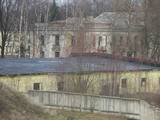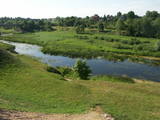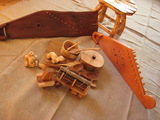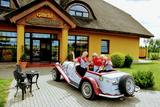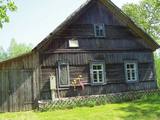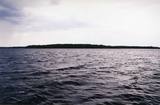| Nr | Name | Beschreibung |
|---|---|---|
|
This is on the north-western shore of Lake Lielezers of Limbaži, at the start of the Lielezers nature trail. The tower opens up a view of the lake and its lovely shores. It is worth walking the trail, which is several kilometres long, because it is an interesting one. This is part of the ZBR. |
||
|
Die zentrale und auch schönste Straße in Trakai mit bunten Holzhäusern. Eins der seltenen Kenesa-Gebetshäuser der Welt – ein eingeschossiges Holzhaus mit einem bläulichen Dach. |
||
|
Die prächtige Kiefer in Bigauņciems
bei dem Café Dižpriede.
|
||
|
In den 40er Jahren des 17.Jh. erbaute die schwedische Armee hier eine moderne Festung mit fünf Bastionen und zwei Toren. Hier befanden sich 120 Kanonen und Mörser, Soldaten-Kasernen, Offizierswohnungen, eine Garnisonskirche, Lebensmittel – und Munitionslager. Als Folge des Großen Nordischen Krieges fiel die Festung 1710 in die Hände der russischen Armee. Auch nach der Besetzung Lettlands 1940 stationierte die Sowjetunion hier Einheiten ihrer Marine. Von außen sind Mauern, Bastionen, der Festungsgraben und ein kleiner Teil der alten Kirche zu sehen. Neben der Festung befindet sich ein ehemaliges sowjetisches Militärgelände mit verlassenen Gebäuden und einem Denkmal für Soldaten, die auf U-Booten ihren Dienst geleistet haben. Die Festung ist samstags und sonntags für Besucher geöffnet. |
||
|
Der Bauska Naturpark verläuft für mehrere Dutzend Kilometer am Lielupe-Fluß und an seinen Nebenflüssen – der Mūsa und der Mēmele – entlang. Das ist ein geschütztes Territorium. Die Ufer dieser Flüsse enthalten einige der größten Dolomitklippen in Zemgale. Diese sind sowohl als Biotop als auch als geologisches Denkmal geschützt. Die Flüsse sind wichtige Laichplätze für Flussneunaugen und Zährten. Touristen werden von der Kulturlandschaft des Gebietes beeindruckt sein, genau wie von den Kulturdenkmälern wie z.B. vom Schloß Bauska, dem Park Jumpravmuiža, dem Mežotne - Burgberg und - Schloß, dem Vīna - Berg usw. Die Flüsse sind für Wassertourismus geeignet.
|
||
|
Bis zum 13. Jh. gehörte der Kreis von Smiltene zu dem von den Letgallen bewohnten Land Tālava. Nach der Invasion der Kreuzritter hat den Kreis der Erzbischof von Riga bekommen und am steilen Ufer des Flusses Abuls hat er im Jahr 1370 eine Burg gebaut. Die nachfolgenden Kriege und Seuchen haben weder die Bebauung der Ortschaft, noch die Einwohner geschützt. Die heutigen Konturen der Stadt begannen sich am Ende des 19. Jhs. mit den aktiven Tätigkeiten des Barons von Lieven – des Landgutinhabers von Smiltene – zu bilden. Bis zum Ersten Weltkrieg arbeitete in Smiltene eine Holzverarbeitungsfabrik, ein Wasserkraftwerk (1901, das erste in den Baltischen Ländern) und andere Unternehmen. Als sich im Jahr 1944 die deutschen Streitkräfte zurückgezogen haben, wurde in einem Brand der größte Teil der historischen Bebauung der Stadt zerstört. |
||
|
Guntis Niedoliņš is a master craftsman, and at this workshop he manufactures wooden jewellery, furniture, interior design objects, spoons, shovels, etc. |
||
|
Der Ort, dem sich der Hof befindet, ist nach der Erinnerung von Altansässigen das einstige Zentrum des Dorfes Domantai. Der Hof besteht aus 4 Gebäuden, die in der Tradition der regionalen Architektur stehen: Schenke, Speicher, Sauna und beidseitiges Wohnhaus. |
||
|
Das Gästehaus befindet sich am Rande der Straße von Vidzeme (A2) zwischen Ape und Jaunlaicene. Es ist ein landschaftlich sehr schöner Ort, den man aus einem Aussichtsturm genießen kann, die die Wirte gebaut haben. Lettische Küche: Brühe mit gebrühten Teigstücken Profitroļi, geschmortes Sauerkraut mit Graupen und Schinken, gefüllte Schnitzel mit Waldpilzen, marinierte Geflügelleber in Tomatensoße, Rouladen aus Nackenschnitzel, Rhabarbercreme mit Beerensoße. |
||
|
Ein kleiner Bauernhof mit einem besonderen Lebensstil von Saaremaa, der Heilkräuter und Gewürzpflanzen anbaut und deren Herstellung, Verarbeitung und Handel betreibt. Die Gäste können einen Spaziergang im Garten unternehmen, die Pflanzen selbst sammeln und an Workshops teilnehmen. |
||
|
The House-Museum of the writer Michael Narics. Reveal the history of political repressions in the
USSR and Soviet Latvia; see creative works of the winners of competition organized by M. Narics Educational
Center.
Working hours: on request |
||
|
Die Wirtschaft Lazdiņi ist eine der modernsten Wirtschaften in Lettland, sie befindet sich am nordwestlichen Teil des Flachlandes der Region Zemgale, in der Gemeinde Krimūnas. Die Wirtschaft hat sich auf die Züchtung (ungefähr 1100 ha), Aufbereitung und Aufbewahrung von Getreidepflanzen spezialisiert. Der Wirt Juris Lazdiņš ist der Leiter der größten nicht staatlichen Organisation für Landwirte in Lettland. Mit vorheriger Anmeldung können erfahrene und neue Fachleute der Landwirtschaft die Wirtschaft besuchen, um Erfahrung zu teilen. In der Umgebung breitet sich Flachland aus, das eine typische Landschaft der Region Zemgale ist. |
||
|
Atrodas Jasmuižas austrumdaļā. Dievnams celts 1815. g., bet pārbūvēts 1932. g. |
||
|
Das ist Lettlands ältestes Naturreservat und, in der Tat, das älteste geschützte Gebiet des Landes. Moriscala ist eine Insel im See Usma, der der fünftgrößte See in Lettland ist. Das Reservat wurde 1912 auf Initiative einer Gruppe von Naturstudenten von Riga begründet. Sie wollten den Eichenlaubwald auf der Insel schützen und zugleich die örtliche Flora und Fauna. Das Naturreservat schließt auch die Insel Lielalksnīte ein. Besuche des Reservats sind jedoch streng verboten.
|
||
|
Das Restaurant befindet sich am Platz des Herzogs Jacob. Köche verwenden hier lokale Produkte und arbeiten mit dem Hirschgarten Rudiņi zusammen. Lettische Küche: Kalte Suppe, Hirschgulaschsuppe, Hirschschnitzel, gebratener Zander oder Wels, Schweinebraten, geschmortes Lammfleisch, Kartoffelpfannkuchen, Dessert aus Sanddornbeeren. Das besondere Gericht: Rindersteak auf Stein. |
||
|
Das Museum befindet sich am Rande der Landstraße zwischen Jaunpiebalga und Vecpiebalga. Das Museum „Jāņaskola” wurde 1969 eröffnet. Die Ausstellungsgegenstände des Museum spiegeln den Lebensweg der zwei hervorragenden lettischen Personen – Emīls Dārziņs (1875 – 1910) und Jāņis Sudrabkalns (1894 – 1975) wider. Im Museum ist es möglich, Musikwerke von E. Dārziņš zu hören. Das Museum bietet auch die Exkursionen für individuelle Besucher und Gruppen, sowie Vortrags- und Musikabende an. |
||
|
This is the thickest and mightiest Norwegian spruce (Picea abies) in Latvia. Its monolithic trunk, with its small holes, is unusual. The tree is in the overgrown park of the former Īve Estate, behind the ruins of the mansion.
|
||
|
Das Gebäude ist im Jahr 1800 gebaut und im Jahr 1825 umgebaut worden. Die katholische Kirche von Zosna ist eine der kleinsten hölzernen Kirchen in der Region Latgale und das älteste Gotteshaus im Nationalpark Rāzna. In dem Gebäude befindet sich ein bekanntes Altargemälde Madonna mit dem Kind. Bemerkenswert sind auch das Tor, der Zaun (aus roten Ziegelsteinen und Feldsteinen gebaut) und der Glockenturm. Unweit von der Kirche wohnt die Verwalterin der Kirche, mit der man sich über den Besuch der Kirche einigen kann. |
||
|
Atrodas 3 km dienvidos no Velēnas luterāņu baznīcas. Savdabīgo akmens velna skulptūru 1955. g. kā „pieminekli” meliorācijas darbiem veidojis vietējais iedzīvotājs Vilis Zvaigznītis. |
||
|
Mākslinieka un koktēlnieka Antano Česnulio koka skulptūru parks atrodas Naujasodė ciematā, aptuveni 3 km attālumā no Druskininku pilsētas. Ekspozīcija tiek regulāri atjaunota ar jauniem darbiem. |
||




